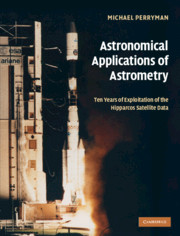Book contents
- Frontmatter
- Contents
- Preface
- 1 The Hipparcos and Tycho Catalogues
- 2 Derived catalogues and applications
- 3 Double and multiple stars
- 4 Photometry and variability
- 5 Luminosity calibration and distance scale
- 6 Open clusters, groups and associations
- 7 Stellar structure and evolution
- 8 Specific stellar types and the ISM
- 9 Structure of the Galaxy
- 10 Solar System and exoplanets
- Appendix A Numerical quantities
- Appendix B Acronyms
- Appendix C Author gallery
- Index of first authors
- Subject index
7 - Stellar structure and evolution
Published online by Cambridge University Press: 23 November 2009
- Frontmatter
- Contents
- Preface
- 1 The Hipparcos and Tycho Catalogues
- 2 Derived catalogues and applications
- 3 Double and multiple stars
- 4 Photometry and variability
- 5 Luminosity calibration and distance scale
- 6 Open clusters, groups and associations
- 7 Stellar structure and evolution
- 8 Specific stellar types and the ISM
- 9 Structure of the Galaxy
- 10 Solar System and exoplanets
- Appendix A Numerical quantities
- Appendix B Acronyms
- Appendix C Author gallery
- Index of first authors
- Subject index
Summary
Introduction
While the chemical composition, temperatures and pressures deep in stellar interiors are out of reach of direct investigation, their observational consequences in terms of stellar luminosity, surface temperature, radii, masses, surface chemical composition, seismological oscillations, Galactic chemical enrichment, etc. are more directly accessible.
Stellar evolution is driven by changes in chemical composition caused by nuclear reactions. The development of numerical codes to calculate models of stellar structure and evolution began some 50 years ago with the pioneering works of Schwarzschild (1958) and Henyey et al. (1959). Matching resulting stellar models to a wide range of astronomical observations has been a hugely extensive and extremely successful field of research over many decades. Continuously improving models combined with advances in many observational areas have led to a progressively deeper understanding of the numerous physical processes that occur during the various stages of stellar formation and evolution.
Currently, the Sun provides the most stringent tests of theories of stellar structure and evolution. Its surface chemical composition is generally considered to be well-determined (Anders & Grevesse, 1989), although a significant decrease in metal content of the convection zone has recently been inferred from 3d hydrodynamical models (Asplund et al, 2005; Grevesse et al., 2007).
Information
- Type
- Chapter
- Information
- Astronomical Applications of AstrometryTen Years of Exploitation of the Hipparcos Satellite Data, pp. 339 - 412Publisher: Cambridge University PressPrint publication year: 2008
